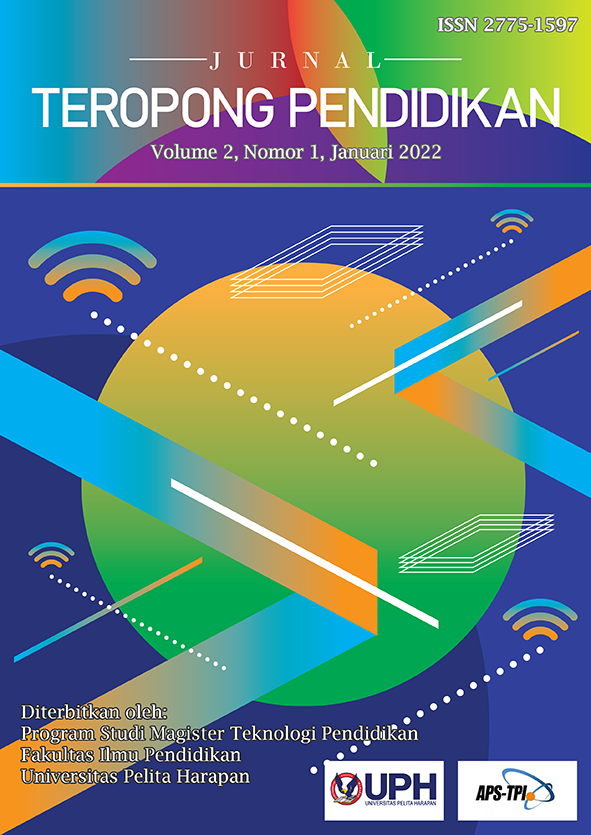Meningkatkan Keterampilan Proses, Tanggung Jawab, dan Penguasaan Konsep pada Mata Pelajaran Fisika Kelas 10 SMA Lentera Harapan Curug Melalui Penerapan Model Pembelajaran Cycle 7E [Improving Process Skills, Responsibility Attitude, and Mastery Concept in Physics Lesson of Ggrade 10 SMA Lentera Harapan Curug Students Through Learning Model Application Cycle 7E]
DOI:
https://doi.org/10.19166/jtp.v2i1.5064Keywords:
Cycle 7E learning model, process skills, responsibility, mastery conceptAbstract
This research aims to find out the improvement of three learning competencies that are process skills, responsibility attitude, and mastery concept students through learning model application cycle 7E in Physics. The three competencies are very important to be mastered by the students. The research implemented on grade 10 SMA Lentera Harapan Curug students from July to November 2016. The research method is weak experimental design the static-group pretest-posttest. The data obtained using questionnaire and written test to get the mean value and n gain, to see the difference between the experimental class and control class used by Mann Whitney test for process skills and responsibility attitude, and the t-test the mastery concept. The conclusion of Wilcoxon test for process skills, responsibility attitude, and concepts mastery is that there were significant differences in pretest and posttest results of the experimental class by using model 7E cycle learning.
References
Anjarsari, P. (2012). Peningkatan kompetensi profesionalisme guru sains berkelanjutan melalui penelitian dan publikasi ilmiah. Universitas Pendidikan Indonesia.
Arends, R. I. (2008). Learning to teach: Belajar untuk mengajar. Pustaka Pelajar.
Diana, S., Racmatulloh , A., & Rahmawati, E. S. (2015). Profil kemampuan literasi sains siswa SMA berdasarkan instrumen scientific literacy assesments (SLA). Seminar Nasional XII Pendidikan Biologi FKIP UNS (pp. 285-291).
Djamarah, S. B. (2005). Guru dan anak didik dalam interaksi edukatif: Suatu pendekatan teoritis psikologis. Rineka Cipta.
Eisenkraft, A. (2003). Expanding the 5E model: A proposed 7E model emphasizes “transfer of learning” and the importance of eliciting prior understanding. The Science Teacher, 70, 56-59.
Ekohariadi. (2010). Perkembangan kemampuan sains siswa Indonesia usia 15 Tahun berdasarkan data studi Pisa. Pusat Penilaian Pendidikan Badan Penelitian dan Pengembangan Kementrian Pendidikan Nasional.
Fraenkel, J. R., & Wallen, N. E. (2008). How to design and evaluate research in education (7th ed.). McGraw-Hill.
Ikawati, M. V. (2014). Pencapaian kemampuan inkuiri dan peningkatan penguasaan konsep melalui penerapan model pembelajaran Team Game Tournament dalam pelajaran science kelas 1 SD Swasta XYZ [Thesis, Universitas Pelita Harapan]. Universitas Pelita Harapan Institutional Repository. http://repository.uph.edu/31161/
Indrawati, W., Suyatno., & Rahayu, Y. S. (2014). Implementasi model learning cycle 7 E pada pembelajaran kimia dengan materi pokok kelarutan dan hasil kali kelarutan untuk meningkatkan penguasan konsep dan keterampilan berpikir kritis siswa SMA. Prosiding Seminar Nasional Kimia (pp. 32-39). Jurusan Kimia FMIPA Universitas Negeri Surabaya.
Joyce, B., Weil, M., & Calhoun, E. (2011). Models of teaching: Model-model pengajaran. Pustaka Pelajar.
Lauer, T. E. (2003). Conceptualizing ecology: A learning cycle approach. The American Biology Teacher, 65(7), 518-522. https://doi.org/10.2307/4451551
Majid, A. (2014a). Penilaian autentik proses dan hasil belajar. Remaja Rosdakarya.
Majid, A. (2014b). Strategi pembelajaran. Remaja Rosdakarya.
Mecit, Ö. (2006). The effect of 7E learning cycle model on the improvement of fifth grade students' critical thinking skills [Thesis, Middle East Technical University]. https://etd.lib.metu.edu.tr/upload/12607661/index.pdf
Peraturan Menteri Pendidikan dan Kebudayaan Republik Indonesia Nomor 21 Tahun 2016 Tentang Standar Isi Pendidikan Dasar dan Menengah.
Prilantari, H. (2007). Pengembangan bank soal keterampilan proses IPA (biologi) kelas X tingkat Madrasah Aliyah. Jurnal Penelitian dan Evaluasi Pendidikan, 10 (2), 223-234. https://doi.org/10.21831/pep.v10i2.1984
Sari, D. E., & Susilaningsih, E. I. (2013). Penggunaan model direct instruction sebagai upaya peningkatan pemahaman siswa melalui kertas kerja. Jupe-Jurnal Pendidikan Ekonomi, 2(1), 11-25. https://jurnal.fkip.uns.ac.id/index.php/ekonomi/article/view/2618/0
Sedyawati, E. (1999). Pedoman penanaman budi pekerti luhur. Balai Pustaka.
Semiawan, C. (1992). Pendekatan keterampilan proses. Gramedia.
Silaban, B. (2014). Hubungan antara penguasaan konsep fisika dan kreativitas dengan kemampuan memecahkan masalah pada materi pokok listrik statis. Jurnal Penelitian Bidang Pendidikan, 20(1), 65-75. https://jurnal.unimed.ac.id/2012/index.php/penelitian/article/view/3072
Silaban, S. S., & Utari, S. (2015). Analisis didaktik berdasarkan profil penguasaan konsep siswa pada materi suhu dan kalor. Prosiding Simposium Nasional Inovasi dan Pembelajaran Sains 2015 (pp. 521-524). https://ifory.id/abstract/mcjvt2LWudbx
Sugiyono. (2008). Metode penelitian pendidikan: Pendekatan kuantitatif, kualitatif, dan R & D. Alfabeta.
Suryosubroto, B. (2002). Proses belajar mengajar di sekolah. Rineka Cipta.
Suyadi. (2013). Strategi pembelajaran pendidikan karakter. Remaja Rosdakarya.
Trianto. (2010). Model pembelajaran terpadu: Konsep, strategi, dan implementasinya dalam kurikulum tingkat satuan pendidikan (KTSP). Bumi Aksara.
Winkel, W. S. (1991). Psikologi pengajaran. Grafindo.
Wisudawati, A. W., & Sulistyowati, E. (2014). Metodologi pembelajaran IPA: Disesuaikan dengan pembelajaran kurikulum 2013. Bumi Aksara.
Wuryanano. (2007). The 21 principles to build and develop fighting spirit. Elex Media Komputindo.
Yaumi, M. (2013). Prinsip-prinsip desain pembelajaran. Prenada Media.
Yenilmez, K., & Ersoy, M. (2008). Opinions of mathematics teacher candidates towards applying 7E instructional model on computer aided instruction environments. International Journal of Instruction, 1(1), 49-60. https://eric.ed.gov/?id=ED524158
Downloads
Published
Issue
Section
License
Authors who publish with this journal agree to the following terms:
1) Authors retain copyright and grant the journal right of first publication with the work simultaneously licensed under a Creative Commons Attribution License (CC-BY-SA 4.0) that allows others to share the work with an acknowledgement of the work's authorship and initial publication in this journal.
2) Authors are able to enter into separate, additional contractual arrangements for the non-exclusive distribution of the journal's published version of the work (e.g., post it to an institutional repository or publish it in a book), with an acknowledgement of its initial publication in this journal.
3) Authors are permitted and encouraged to post their work online (e.g., in institutional repositories or on their website). The final published PDF should be used and bibliographic details that credit the publication in this journal should be included.





